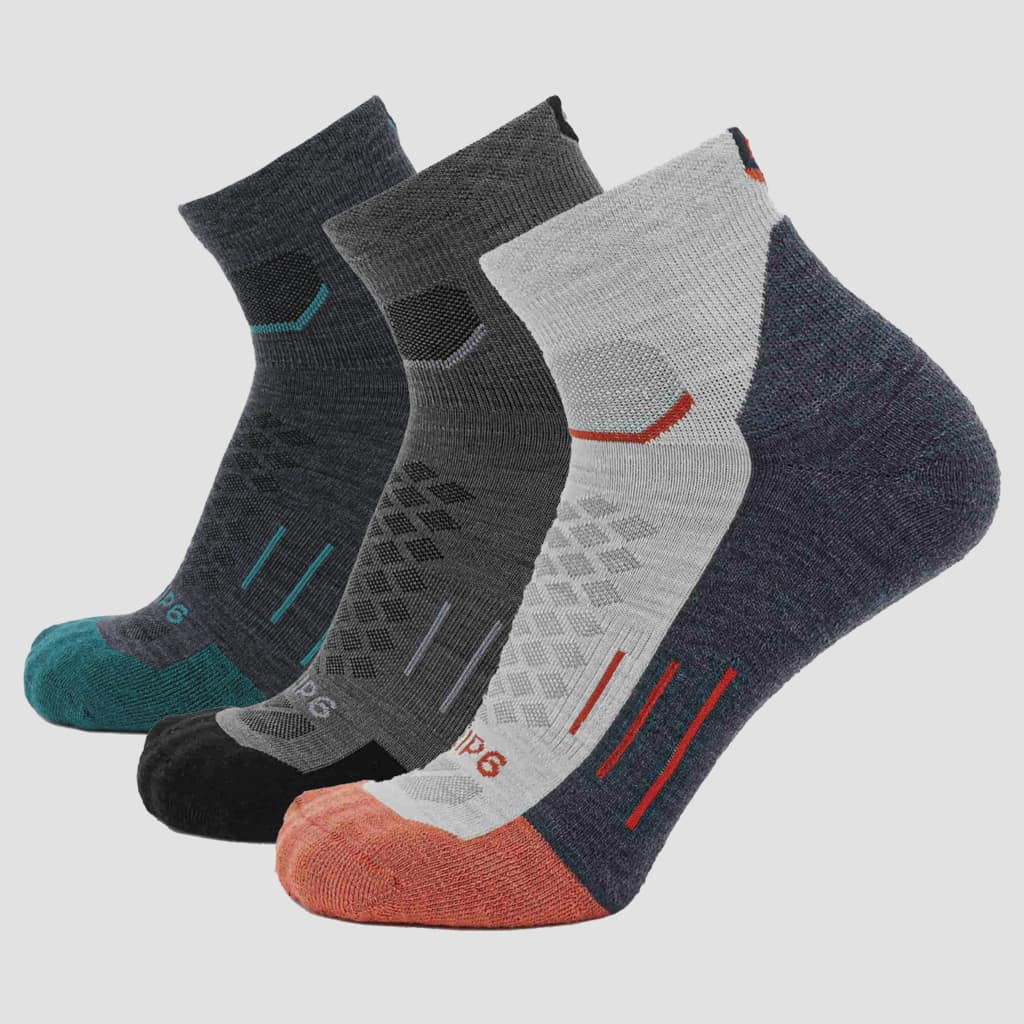Wool is a super fiber. It’s a game-changing material made in the USA which puts cotton to shame again and again. Here, we’re answering common questions about wool and why we believe it’s the best material to make socks out of.
Does wool keep me that much warmer?
Wool is second only to goose-down in insulation ability. It will help keep you warm in extreme conditions as well as wick moisture from your skin, so if you plunge into water or get caught in the rain, you’ll dry off faster.

Can I wear wool in the heat?
Because of its moisture-wicking properties, wool is great for activities where you’ll be sweating. But the best way to describe wool is being like a styrofoam cup. It keeps hot drinks hot and cold drinks cold, insulating the temperature of the thing it surrounds. Wool does largely the same thing.
Wool has “heat of sorption” properties, which means it holds onto heat when it’s cold and releases heat when it’s warm. Tiny pockets in the fibers fill with air to insulate you, keeping your skin a steady temperature.
And, when you sweat, the water vapor won’t stay on your skin. Instead, the wool moves the water through the core of the fibers and then releases it into the air, keeping your feet dry even on a hot day.
What happens when I sweat in Merino wool?
Nothing! That’s the beauty of it. Merino wool absorbs liquid right off your skin, and can absorb more than 30% of it's weight before it begins feeling damp. And, even when it’s wet, it retains 80% of its insulation ability.
The fibers in the wool are hydrophilic, meaning they attract water. The water vapor from your skin moves into the core of the fibers and then evaporates into the air, keeping you and the wool dry to the touch. Wool releases water much more quickly than other fibers, making it a superior moisture-wicking fabric.
What's the difference between Merino and Rambouillet wool?
Merino wool comes from the Merino breed of sheep, which are known to withstand very extreme temperatures. In America, we get a similar type of wool from a sheep called Rambouillet sheep, which is essentially a cousin to the Merino.
Rambouillet sheep have wool coats that can keep them warm in below freezing environments and cool on hot summer days. Rambouillet wool is unique because it performs so well in a variety of circumstances, which the sheep themselves can attest to.
Merino and Rambouillet wool are the thinnest wool fibers available. The fibers are long and strong (even stronger than silk!) which helps it withstand tearing and ripping.
Rambouillet sheep in particular have coats that produce a long staple length, resulting in a softer, finer material. Rambouillet sheep's coats also have a natural crimp, meaning it can be molded and shaped more easily.
All in all, the Rambouillet is a fantastic close cousin to the Merino, giving Americans a domestic wool source.

Does Merino wool last longer than other fabrics?
Yes. Wool can bend 20,000 times before it breaks, but cotton can only bend 3,000 times. This makes wool a more durable fabric overall.
However, in order to make wool last longer and be more flexible, most companies mix other fabrics into their wool blend. At GRIP6, we use a mix of wool, nylon, and elastic to create the best sock possible. Synthetic materials last even longer than wool, making the blends a super durable fabric.
Is wool itchy?
Depends on what you get. Merino wool’s fibers are long and thin, making them smooth and comfortable against the skin. Other wool variations, like the ones used in thickly-knit sweaters or blankets, feel different against the skin than our socks.
Blending other fibers with wool is a common way to make the fabric smooth and soft.

Is it true that wool eliminates odors?
Yes. Merino wool is great for masking odors because of its antibacterial properties. This makes it perfect for long days on the trail or just re-wearing your favorite socks a few times.
Because of the moisture-wicking properties, wool keeps your feet from sweating and forming odors that way.
You can go more times between washing, making wool a great water-saving option.
Is Merino wool less harmful for the environment than other fabrics?
Compared to many other fabrics and fibers, Merino wool is a better choice for the environment.
Starting with waste and pollution, Merino wool is overall much better. It only takes six months for merino wool to break down, which is a big difference compared to the multiple centuries that other materials spend breaking down.
Wool is a renewable resource, because wool from the same sheep is shorn year after year as long as the sheep lives. This is far better than synthetic materials, which are made from nonrenewable resources.
Because wool comes straight from the animal, it does not contain microplastics and therefore does not release plastics into the ocean. Microplastics are a major problem caused by synthetic materials, and the use of wool rather than other materials is a great option to help reduce these harmful effects.
Here in the mountain west, sheep are being used to help mitigate fires and reduce the risk of massive wildfires spreading. Through targeted grazing, sheep eat dry grass before it becomes a fire danger.
Overall, the net environmental cost of using wool for socks is much less than using other materials.

Pictured above: our sock machine under the glow of the night lights when the manufacturing facility is closed up for the day.
Is wool flammable?
No. Wool requires more oxygen than is present in the air to catch on fire, so you don’t have to worry about your merino wool products being flammable unless you throw them directly into a fire.
Our socks are fire-resistant, because the materials that aren’t wool can catch fire.
How do I clean merino wool?
The same way you’d clean anything else, it’s just much easier. Wool fibers overlap, which keeps dirt, dust, odors, and anything else you don’t want in your clothes on the surface, so it’s easier to clean. That’s why our socks are built to get dirty!
Wool washes well in cold water and dries with low heat. You can wash your wool products less frequently because they do not hold odors easily. For best results, we recommend washing your socks inside out.

What should I do when my merino wool products wear out?
Many companies recycle wool, so we recommend checking what’s available locally so you can drop your products off to be recycled.
If your wool socks are from GRIP6 and they get damaged, you can submit a request to have a new pair sent to you! Email grip6@grip6.com with an image of the problem and your order number, and reap the benefits of our lifetime guarantee!
Why are our products not 100% wool?
Integrating nylon and elastic allows our products to be more comfortable, last longer, and have better elasticity. It also makes the sock more comfortable and wearable for everyday use.
We have also found that 100% wool products are much more expensive than products crafted with a mix of materials. Because we like to keep products within a reasonable price range for consumers, we chose a blend of wool instead.
Where does GRIP6 wool come from?
All GRIP6 wool is sourced from the Mountain West. The wool is shipped to our manufacturing facility in Salt Lake City, Utah where the socks are made in-house.







12 comments
Mitch Liner
I have 4 pairs of your socks and I love them. They are the best fitting socks I own, they wear like iron, and have both the wicking ability and warmth that you claim. But when are you going to get nicer colors? Solids would be great.
Jose
Awesome
Donald B Schlag
This article almost made it sound like Rambouillet wool was a better choice than Merino. Why do you use Merino?
KenC
I like my comfortable Grip6 “Overland” socks – I’m wearing them right now. But they had to be exchanged once. With my Size 12 shoe size, I first ordered what the sizing chart showed: a Large pair. They were much too small. I exchanged them for an XL pair, which are supposed to be for Sizes 12.5 to 15. They are perfect. That these sock sizes run small should be noted – and seems unusual for an American-made product.
Ed
What percent is wool??
Leave a comment
All comments are moderated before being published.
This site is protected by hCaptcha and the hCaptcha Privacy Policy and Terms of Service apply.